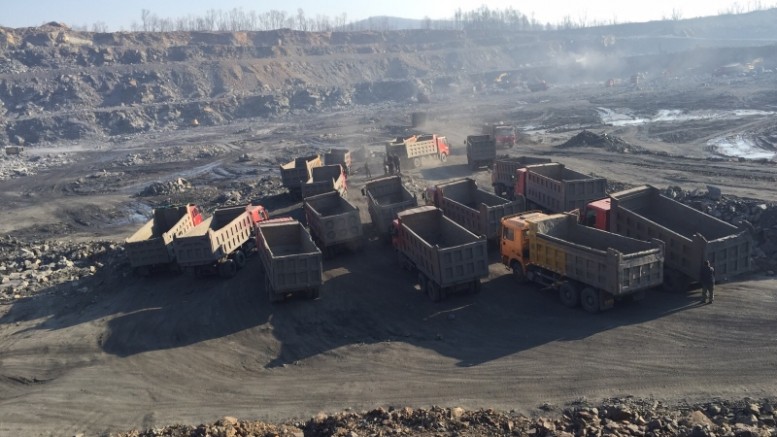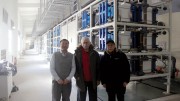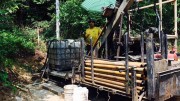VANCOUVER — Two years ago Flinders Resources (TSXV: FDR; US-OTC: FLNXF) was flying high as the “only Western producer of natural flake graphite” at its historic Woxna mine, 8 km northwest of the town of Edsbyn, Sweden. The company held its opening ceremony in September 2014, and the 100,000-tonne-per-year operation is capable of cranking out nearly 10,000 tonnes of 90% carbon graphite concentrate annually.
Plunging industrial metal markets cut the celebration short, however, with declining global flake graphite demand pushing prices to four-year lows of less than US$700 per tonne by mid-2015.

Graphite mineralization at the Woxna site. Credit: Flinders Resources.
Flinders opted to put Woxna’s return to production on hold, but a recent resurgence in green energy investments — along with a merger — has management optimistic again.
“Potential customers for our current end products are sort of on the cusp of putting their finger on the trigger,” president and CEO Blair Way says during an interview.
“We restarted Woxna with the full intention of catering to the refractory end-user, which was a sizable industry, but it ended up shrinking alongside the global steel business. There really didn’t end up being much of a market to sell into,” he says.
Buzz around electric vehicles and lithium-ion battery demand, driven by companies like Tesla Motors (NASDAQ: TSLA), has brought the spotlight back onto the graphite industry, and spurred furious rallies in other specialty materials like lithium. Flinders is now looking to work its way up the value-add chain and market itself as an integrated technology provider.

The Norra Karr site lies 300 km southwest of Stockholm, Sweden. Credit: Tasman Metals.
The company’s big move was to revisit a proposed merger with Tasman Metals (TSXV: TSM; US-OTC: TASIF), which owns the Norra Karr heavy rare earth element (REE) deposit, 300 km southwest of Stockholm, Sweden. The companies announced a deal in late June wherein Tasman shareholders would receive 0.5 a share of Flinders for each share held. The pro-forma company would be rebranded as Kinetic Materials.
“We’re bringing these companies together and we’re going to relaunch as a technology resource provider. We envision ourselves working with end-users to provide them value-added specialty materials, whether that’s graphite, lithium, cobalt or other elements. What we hear from potential customers is basically a shopping list of what they need to produce these energy solutions,” Way says.
“It’s the new integrated model where we go beyond mining and work with the customer to fill technological need. Investors are big right now on Tesla, which has done a very good job of raising the profile of the sector. We’re looking at becoming a more integral part of the new-world economy,” he adds.

Outcrop at the Norra Karr site. Credit: Tasman Metals.
Tasman released a prefeasibility study on Norra Karr in early 2015 that outlines a US$378-million development, which would have the “the capacity to be a long-term producer of the most critical heavy REEs, plus other critical metals, including zirconium and hafnium.” The company also recently completed test work on nepheline-feldspar by-product, which could represent near-term opportunities to supply Europe’s paint, building product, ceramic and glass markets.
Meanwhile, Flinders is looking at vertical integration at Woxna to work its way up the value-add chain. The company is working towards on-site, battery-grade spherical graphite production, and announced in March it would apply to re-permit Woxna to lift throughput rates and incorporate additions to the processing circuit.
Traditional natural flake graphite pricing was pegged at US$800 per tonne in early 2016, while graphite market analyst Benchmark Minerals indicates that natural flake battery-grade spherical graphite products command prices ranging from US$3,000 to US$4,500 per tonne.
“We’d always planned to pursue the value-add side of the equation, and we had an established high-purity flow sheet to build on,” Way says. “We struggled to find organizations in North America and Europe that really understood the industry, and so we ended up going to China, which supplies the majority of natural flake graphite to the battery sector.”
Flinders is working with a “Chinese technology partner” to finalize a flow sheet for battery-grade graphite, which is based on the “world’s only commercially proven purification methods.”

Graphite processed to various forms during test work. Credit: Flinders Resources.
Way says that “the truth is that even if we were producing a high-purity graphite product right now, we’d be hard-pressed to sell it outside of Japan. There really aren’t battery cells being manufactured anywhere outside of Korea, China and Japan. But now, we’re speaking with companies in Europe and they’re saying they want to get into the business. We’re positioning ourselves for the market growth in Europe and North America.”
As for more speculative graphite applications, Flinders has partnered with Sweden-based 2D Fab AB under the government-run Svenskt Grafen to explore graphene technologies. In 2015, the companies received US$280,000 million in funding to analyze advanced industrial applications for Woxna’s graphite.
In late April, Flinders reported that graphene was produced using 2D Fab’s “proprietary low environmental footprint manufacturing technology,” which uses a low-energy, hydro-mechanical exfoliation process.

The processing plant at Flinders Resources’ Woxna graphite mine in Sweden. Credit: Flinders Resources.
“We’re working with a Swedish company that’s using our flotation concentrate in research on graphene production,” Way says. “The strategy is finding real, commercial applications for the technology. Graphene is essentially a one-molecule thick layer of graphite that has exceptional thermal strength and electrical characteristics. There has been research on applying the technology to construction materials and industrial processes that I think are much more achievable over a shorter term than some of the more speculative ideas like cell phone screens.”
Flinders has traded within a 52-week window of 12¢ to 77¢, and closed at 70¢ per share at press time. The company has 47 million shares outstanding for a $34-million market capitalization, and reported cash of US$2.2 million at the end of April.






Be the first to comment on "Flinders eyes Tasman merger to tap emerging green economy"